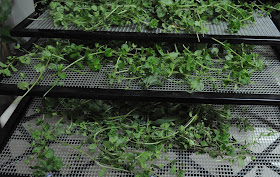 Really, there is nothing prettier in my book than a yard covered in tiny blue. white, and purple flowers, dotted generously with the sunny faces of dandelions. It makes my heart sing! Unfortunately, in the not too distant future this lovely chorus of wildflowers and herbs will become a leggy tangle of plants that have gotten too tall, and are showing their age, yellowing at the base and looking a little worse for the wear. So before the yard gets to that stage, I will harvest the plants that I use for medicine, and will be continually cutting the edible weeds for salads and to add to prepared foods, until the day my husband declares that he is cutting the "grass" when he gets home from work. Well...I got the word this morning as my husband headed out the door for work, "You did hear me say I was cutting the grass this afternoon didn't you?", which is my husband's gentle reminder that if I want my weeds, this is my last chance to get them before he begins mowing for the year.
Really, there is nothing prettier in my book than a yard covered in tiny blue. white, and purple flowers, dotted generously with the sunny faces of dandelions. It makes my heart sing! Unfortunately, in the not too distant future this lovely chorus of wildflowers and herbs will become a leggy tangle of plants that have gotten too tall, and are showing their age, yellowing at the base and looking a little worse for the wear. So before the yard gets to that stage, I will harvest the plants that I use for medicine, and will be continually cutting the edible weeds for salads and to add to prepared foods, until the day my husband declares that he is cutting the "grass" when he gets home from work. Well...I got the word this morning as my husband headed out the door for work, "You did hear me say I was cutting the grass this afternoon didn't you?", which is my husband's gentle reminder that if I want my weeds, this is my last chance to get them before he begins mowing for the year.I have been cutting dandelion greens and Indian strawberry, plantain, and chickweed to eat fresh for a couple of weeks. But I have been letting one of my other medicinal plants get tall, so that I could harvest as much as possible in one cutting. This plant is Speedwell, Veronica Officinalis, also known as Veronica, and Gypsy weed. So since it is mowing day, I went out and cut back the Speedwell to about four inches from the ground.
Then I took the harvest inside to sort it out. Since Speedwell has a sprawling habit its stems can be tangled and intermingled with grass, clover and other herbs and wild flowers, so it is important to spread out the harvest and sort through it making sure to pick out any other plants that may come along with the Speedwell when it is cut.
 |
| Skittle is helping me sort |
 |
| Clover, grass, False Dandelion flowers, leaves and grass seed don't belong in the mix! |
Speedwell is a small perennial plant that creeps close to the ground. It has woody, hairy stems that send up branches from 3 to 10 inches high and is rooted at the joints. The leaves are paired in opposites on the stems, and are grey green in color and have finely toothed edges. It has lovely, light blue flowers that have violet streaks inside that draw the attention of bees. The flower is about the size of the eraser on a pencil. The seed pods are heart shaped. En masse they make a very cheerful carpet of blue flowers and grey green foliage in early spring.
 |
| Here is a look at what the whole plant looks like |
 |
| The tiny Speedwell flowers are a pretty shade of blue, with stripes of violet or darker blue. My finger is in the photo for scale. |
As I finish this post I hear the mower running, inside I have the dehydrator going, drying my harvest of Speedwell. It has been a good day, I hope yours was too! See you again tomorrow!
























